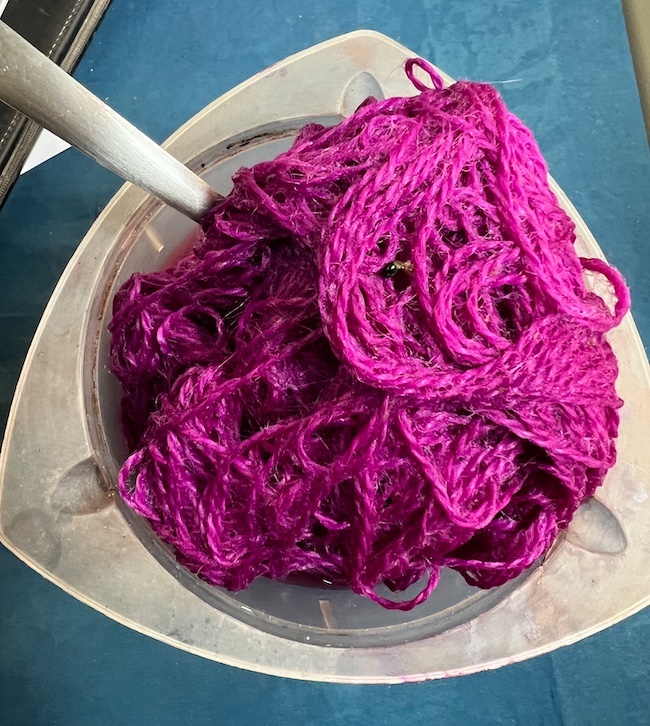
We’re pretty obsessed with pokeberry dyeing right now for dyeing wool, making ink and just squishing them up and dropping them on paper. They are SO intense and exciting to use.
I visited Japanese textile artist and katazome instructor John Marshall in his studio in Covelo, Mendocino County and was surprised to see that his entire front yard was covered in pokeberry bushes.
Although pokeberries are native to most of the the United States, I had never even heard of them and was browsing through Rebecca Burgess’ book Harvesting Color on natural dyes when I spotted a beautiful red skein of wool. Thinking it was cochineal, I took a closer look and realized it was a berry that was making this incredible color.
John helped me pick a bag of them and I was anxious try them out. The mordant and dye process was simple and the color is amazing. Burgess’ recipe is based on research by Carol Leigh Brack-Kaiser of Hill Creek Fiber Studio and is a straightforward process of “mordanting” with acetic acid or vinegar and dyeing with an acidic dye bath. It seems to work best on wool, with silk turning out a coral color. The cotton cross ties in my skeins did not absorb any color at all. So I started looking for pokeberry bushes in Seattle and discovered that though they are a North American native species, they are regarded as invasive in the PNW so my idea of growing them next year in the dye garden is probably not a good idea. I guess I’ll just have to return to Mendocino County on a warm autumn day and do my pokeberry gathering there next time.
Pokeberry observations:
1. The rich purple-black color of pokeberry comes from a type of anthocyanin, which is the same type of color found in red beets and amaranth, and it also behaves in a similar manner. That means that it turns very reddish purple with acids and grayish purple with bases (alkali), and that it is not particularly wash or lightfast, so I dye with it with an experimental mindset. It is not going to be a color that I use for artwork or production projects. I store all my pokeberry dyed items in a dark cupboard and do not expose them to excessive light.
2. The mature plant is toxic and so are the berries. Wear gloves when collecting and keep away from small children and pets.
3. The color works with animal fibers (wool, silk, alpaca and mohair) and I’ve had the best results with wool. Silk will dye a lighter color than wool. Pokeberry does not work well on cotton, hemp, linen or other plant fibers but some dyers have had success with it. If you are curious, give it a try.
4. The color seems to work best if you soak the wool in a cold vinegar and water solution, then make a cold dye bath of mashed berries using more vinegar. My technique deviates from the original recipe in that I don’t use any heat at all to preserve the bright shades. The original recipe originates from Carol Leigh Brack-Kaiser and her version is also included in Rebecca Burgess’ book, Harvesting Color.
5. You need to use a lot of pokeberry. Rebecca Burgess recommends a 25:1 ratio. This means for 1 pound of wool fiber, you’d collect 25 pounds of berries, but she reassures you that they are heavy and collecting goes quickly.
6. Soak the fibers overnight in a solution of vinegar and water. You do not use alum for pokeberry if you want a fuchsia shade.
6. Colors such as tan, orange or gray from pokeberries seem to indicate that the dye bath was not acidic enough, or that the skeins were exposed to bright light. I followed Carol Leigh’s recipe exactly and got some very nice results that are still vibrant eleven years later (see top image of my own dyed yarn!)
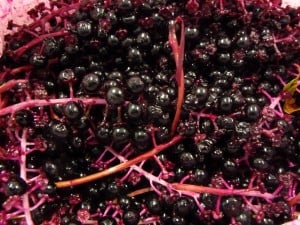
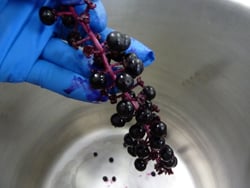
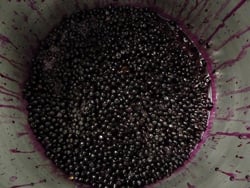
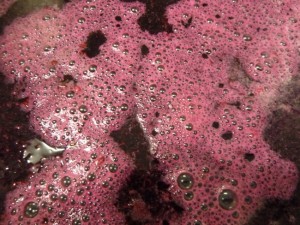
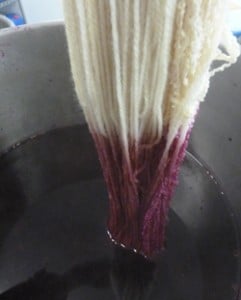
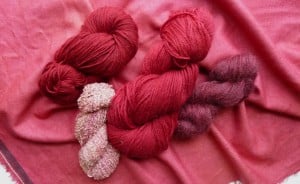

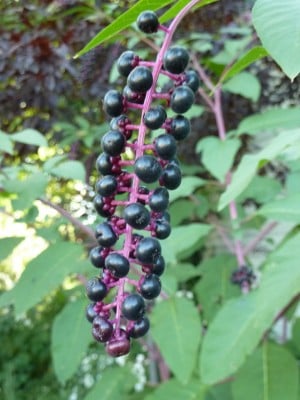
it’s curious how superwash affects wool. i’ve noticed how it increases dye take-up…but also flammability.
it used to be that wool would rarely catch fire and if it did, emitted a nitrogen foam that extinguished the burn. but that doesn’t happen with superwash. the ones i’ve tested just burn. you have to wonder what they do to change the fibre in such a fundamental way!
that said…those are pretty colours!
Hi India,
Thanks for your post. I’ve read that the superwash process is to dissolve the wool scales with a chlorinating compound then coat them with polymer, so it makes sense that it doesn’t have the same self-extinguishing characteristics of natural wool. Mercerized cotton also seems to increase dye take-up too, compared with untreated cotton fibers. The dye process was a lot of fun and I can’t wait until next year to try it again.